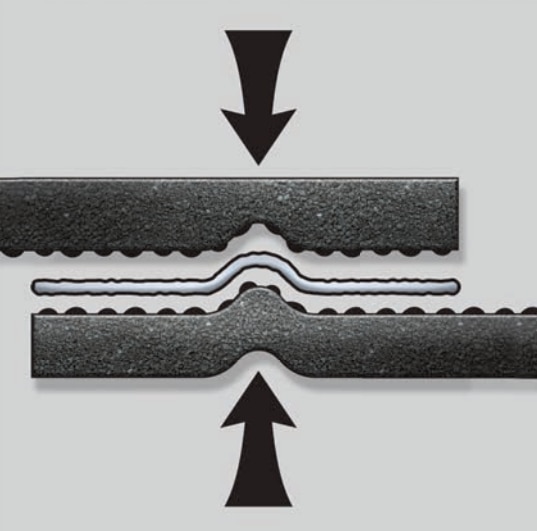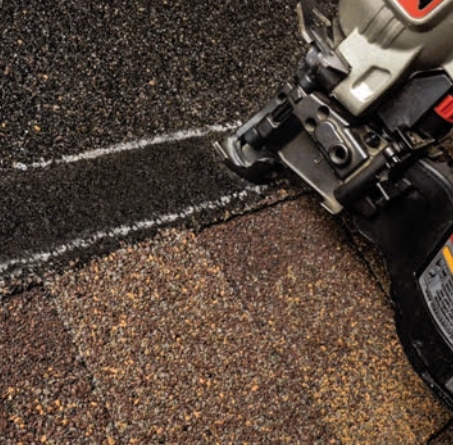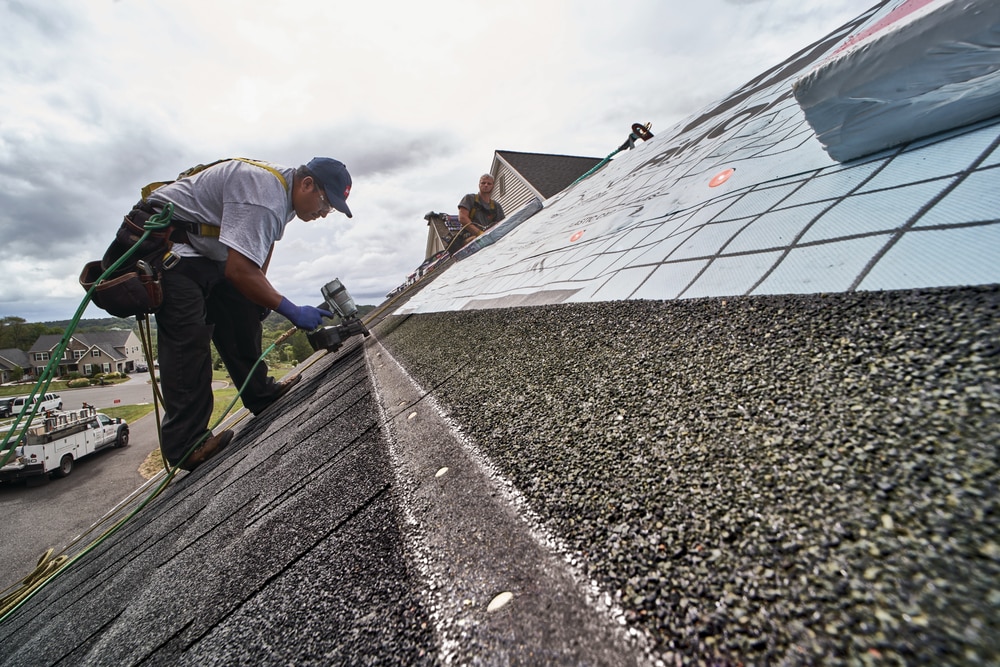The revolutionary LayerLock™ technology, patented by GAF, has changed the game for both roofing contractors and homeowners, making Timberline HDZ® shingles easy and fast to install and providing the industry's first unlimited wind speed warranty.
Let's take a closer look at what this technology is and how it impacts installation.
How Does It Work?
To understand what sets LayerLock™ technology apart, we need to first take a look at how traditional laminate shingles are manufactured versus how Timberline® HDZ shingles are manufactured.
GAF CARE Operations Manager Matt Hegge explained that traditional laminate and architectural shingles are two individual pieces of shingle held together with an asphalt-based adhesive that is applied during the manufacturing process. This is known as the common bond area.
"When asphalt gets hot, it becomes more malleable," says Hegge. "The more malleable it gets, the greater chance that adhesive in the common bond area could loosen and create a separation. The only way to ensure those two pieces stayed together when the roof gets hot was to nail through the common bond area."
New Technology Enhances Common Bond and Increases Nailing Zone
With the development of LayerLock™ technology, the pieces of the shingle are not just held together with adhesive. They are mechanically attached for added strength. "If you look at the back of Timberline® shingles with LayerLockTM technology, you can see dimple marks," explains Hegge. "That is where the two individual shingle pieces are mechanically fastened together during the manufacturing process."
Hegge says that it's similar to a punch press, and the result is that the laminate from the bottom shingle layer is pushed into the top layer during the manufacturing process. This powerful attachment method means that contractors benefit from a larger nailing area.

"We've mechanically fastened the shingle for the contractor and increased the size of the nailing zone by 600 percent compared to Timberline HD shingles," says Hegge. "The StrikeZone™ nailing area is covered with microgranules that make it easier for the Dura Grip™ adhesive to get in and create a strong asphalt-to-asphalt bond. The contractor only needs to use four nails, unless otherwise dictated by local code requirements."
The larger nailing zone and the fact that only four nails are typically required has resulted in faster nail fastening. An independent research lab performed a study that showed Timberline® HDZ shingles were installed up to 30 percent faster than our standard architectural shingles.** During the same test, a contractor was able to place 999 out of 1,000 nails accurately thanks to the large nailing zone.

Contractors Agree on Speed and Accuracy
Nick Branon of Hero Roofing shared the difference the technology has made for his team, saying, "My guys are always worried about trying to hit that common bond so the shingles wouldn't separate over time. With new technology and StrikeZone™, their accuracy is a lot better. They are able to nail out a lot faster, which makes the installs go a lot more efficiently."
Cody Dykes of Superior Roofing agrees that the enlarged nailing area makes a huge difference, saying, "It is almost impossible to miss the wider nailing area with the HDZ. My workers love it. We're in and out because of this StrikeZone™, helping us get a job done quicker."
Three Levels of Warranty Protection
LayerLock™ technology provides unsurpassed warranty protection, with three different levels of warranty coverage, depending on installation.
- Installing just the Timberline® HDZ shingles using four nails in the StrikeZone delivers a 110-mph wind rating.
- To achieve the 130-mph wind rating, you need four nails in the StrikeZone™, plus starter strip shingles at the eaves and on the rakes.
- Finally, to offer the WindProven™ Limited Wind Warranty*, you need to use four nails in the StrikeZone™, plus the required combination of GAF accessory products—GAF starter strips, roof deck protection, ridge cap shingles, and leak barrier or attic ventilation. The WindProven Limited Wind Warranty* is an industry first - wind warranty with no maximum wind speed limitation - and is only available from GAF.
For more information on LayerLock TechnologyTM, click here or reach out to your local Territory Manager.
*15-year WindProven™ limited wind warranty on Timberline® HDZ™ Shingles requires the use of GAF starter strips, roof deck protection, ridge cap shingles, and leak barrier or attic ventilation. See GAF Roofing System Limited Warranty for complete coverage and restrictions. Visit gaf.com/LRS for qualifying GAF products.
**Results based on study conducted by Home Innovation Research Labs, an independent research lab, comparing installation of Timberline HD® Shingles to Timberline® HDZ™ Shingles on a 16-square roof deck using standard 4-nail nailing pattern under controlled laboratory conditions. Actual results may vary.

